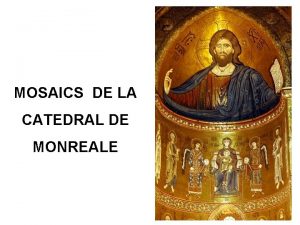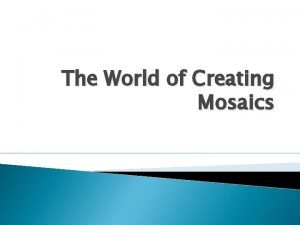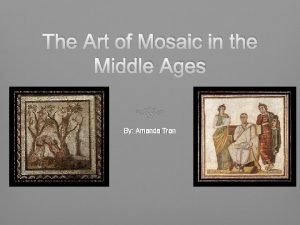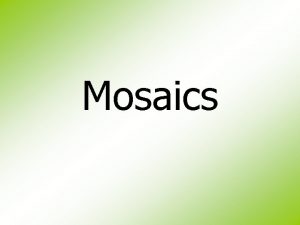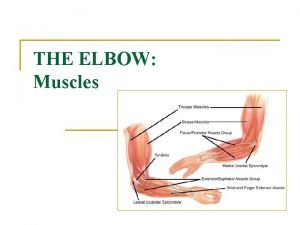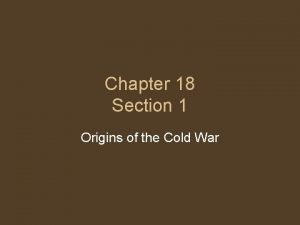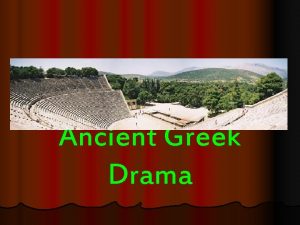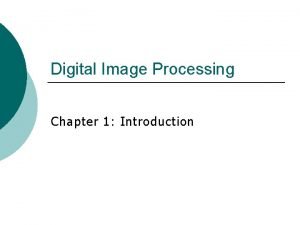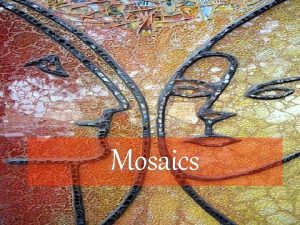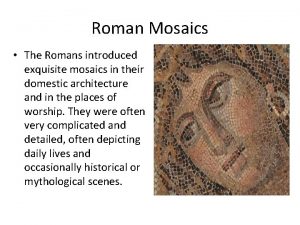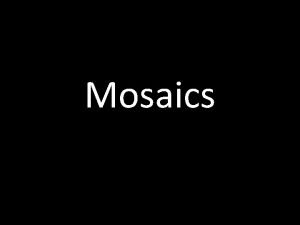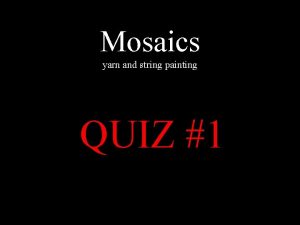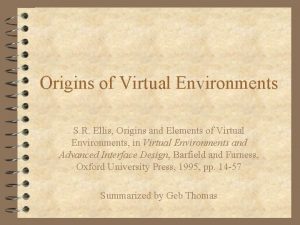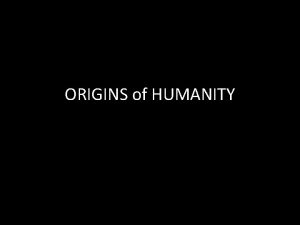mosaics Mosaics in General l Origins l of
















- Slides: 16

mosaics

Mosaics in General l Origins l of Mosaics: Roman mosaics were influenced by the Greek hellenistic era. 5 th Century B. C. Abstract patterns in black and white. Late 5 th B. C. animal and human figures introduced (Greek). 4 th Century B. C. Mythological scenes. 3 rd century B. C. Opus tessellatum originated in Sicily.

Mosaics in General l l Mosaics are called opus tessellatum Made up of cubes called tesserae The tesserae are different coloured marble, tile, other hard stones, brick, glass, metal, pottery. A. D. 1 geometric motive but by A. D. 40 human and animal figures were developing. Emblemata were mosaic paintings made by artists in craftshops. They had all the shading and perspective common to wall paintings. After they were finished the emblemata were brought to a building and inserted into a prepared space in a floor as a centrepiece. These were made of many colours (polychrome)

QUESTIONS TO ANSWER ALREADY 1. 2. 3. 4. 5. 6. 7. 8. What era was the Greek Hellenstic era? What happened in the late 5 th Century? What was introduced in 4 th Century? Where and when was mosaics introduced? What is tesserae? What is Emblemata? What does polychrome mean? Draw a timeline from the previous two slides.

Technique

Technique cont –Trace picture onto mortor, outline of pattern Put in tesserae, tapped with a weight –Grout it, with opus signium covering then wiping it off.

FACT SCAN – COPY THIS l Date: l Type: l Location: l Height: l Width: 125 -134 AD Art: mosaics Hadrians Villa at Tivoli 52 cm 62 cm

DESCRIBE THIS MOSAIC – use the 5 w’s 1 h – brainstorm the name of this mosaic is goats and goatherd

Goats and goat herd l l l l l the scene is set in a rocky landscape, where a flock of goats graze and rest near a stream to the right of the middle ground stands a bronze statue the figure is dressed in Greek fashion in a long belted tunic. It wears a wreath on its head it holds a bunch of grapes in its right hand it holds a staff topped with leaves in the left hand this is probably an image of the god Dionysus leaning against the rock base of the statue is a painting of uncertain significance it has been suggested that it represents an image (a phallus? ) connected with the fertility god Priapus the scene is clearly sacro-idyllic in character

DESCRIBE THIS MOSAIC – use the 5 w’s 1 h!!

THE LION MOSAIC l l l STYLE The bull being attacked shows the techniques used in painting to indicate volume and depth. Shadows cast Body is forshortened with a ¾ view Shading Highlighting Animals outlined

COPY THIS l l l The impression of depth is also given: There is overlapping, and lgiht colours Details vary Smaller in size Clear contrast between ground and sky as background colour is not a soft haze

SIMILARITIES OF BOTH MOSAICS Both mosaics share not only a rich polychromy (various or changing colours) but also certain stylistic features l to create the illusion of depth in the scene and volume in the figures, use has been made of * shading * highlighting * three-quarter views * foreshortening especially the "Lion attacking Cattle" l in "Goats and Goatherd" linear perspective is noticeable in the diminishing scale of the goats the further into the background they appear l such naturalistic characteristics are generally associated with painting particularly Greek painting from the 4 th century BC onwards l

BURSARY QUESTIONS PLATE 4 1. Who owned the villa where this mosaic was found? 2. What technique and materials were used to create this mosaic? 3. What is opis vermiculatum and what ONE advantage is using this method to make mosaics? 4. Compare the mood of this mosaic with the other mosaic you have studied. 5. Discuss the style of this mosaic and give evidence to support your answers.

Essay question - Bursary a) Describe the techniques used by the Romans to make mosaics. Outline the subject matter of ONE of the mosaics found in Hadrian’s villa at Tivoli and explain its stylistic features.

Atmospheric perspective ‘worm work’ the most intricate form of mosaic paving; tiny pieces of tesserae laid in thin, curving lines to create a mosaic picture Emblemata A Greek concept, a mosaic picture created and then inserted into a prepared space in a floor or a wall. Foreshortening Gave the impression object had volume and were lit as they cast a shadow when they intercepted the light Highlighting Little cubes used in creating the mosaics Linear perspective Many colours opus tessellatum Or gradations of the same colour - gave the impression the object had light falling on it and as a result was seen with varying tones to give the effect of light and dark; as if it had volume Opus vermiculatum Or the impression of real space on a flat surface is also suggested by the positioning of objects up or down on the panel, by the overlapping of one object with another, by a lack of detail in objects further away, by a more illusionary or impressionistic depiction of distant objects Polychrome The name of the mosaics Shading Where an object is shown neither front on/full face nor side on/profile but in between, at an angle Shadows Where objects appear to converge in the distance if a series of receding parallel lines were drawn, even though they are in reality not converging Spatial depth Where objects supposed further away or in the background are smaller in size than objects closer to the viewer or in the foreground. tesserae Where objects supposedly further away and disappearing into the distance are in a paler colour than objects closer to the viewer. Three-quarter view Where part of an object is shown shorter in scale than the rest of the object, due to visual perspective Vanishing point Where that part of the object which was supposedly closer to the light source is in a lighter shade than the rest of the object.
 Catedral de monreale planta
Catedral de monreale planta Universal unity mosaics
Universal unity mosaics Mosaic art in medieval period
Mosaic art in medieval period History of mosaics
History of mosaics Diferencia entre gran plano general y plano general
Diferencia entre gran plano general y plano general Where did general lee surrender to general grant?
Where did general lee surrender to general grant? Welcome 1 unit 10 lesson 1
Welcome 1 unit 10 lesson 1 The study of word origins is
The study of word origins is Actions of triceps brachii
Actions of triceps brachii Chapter 1 foundations of government worksheet answers
Chapter 1 foundations of government worksheet answers The origin of species manwha
The origin of species manwha Hunger game
Hunger game Origins of the cold war chapter 18 section 1
Origins of the cold war chapter 18 section 1 Taoism beliefs
Taoism beliefs Origins of theatre
Origins of theatre Block diagram for image processing
Block diagram for image processing Who is the founder of judo
Who is the founder of judo
